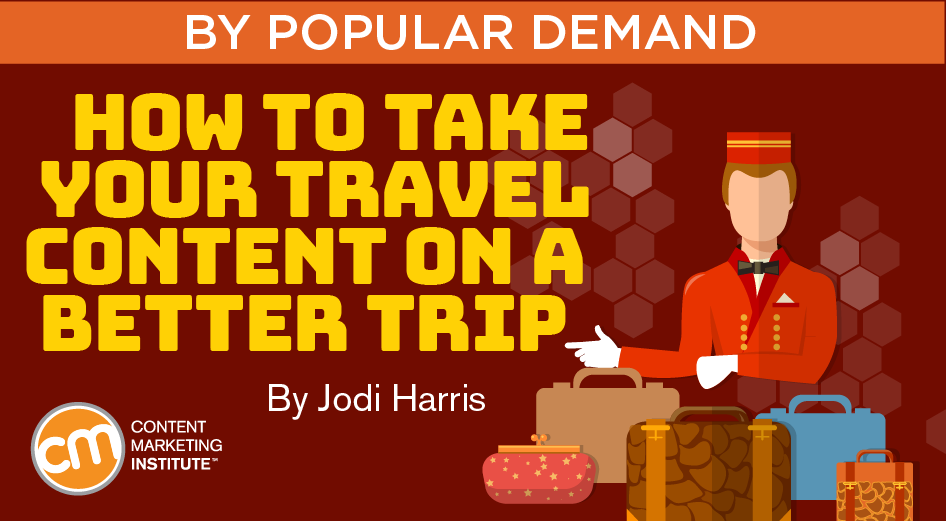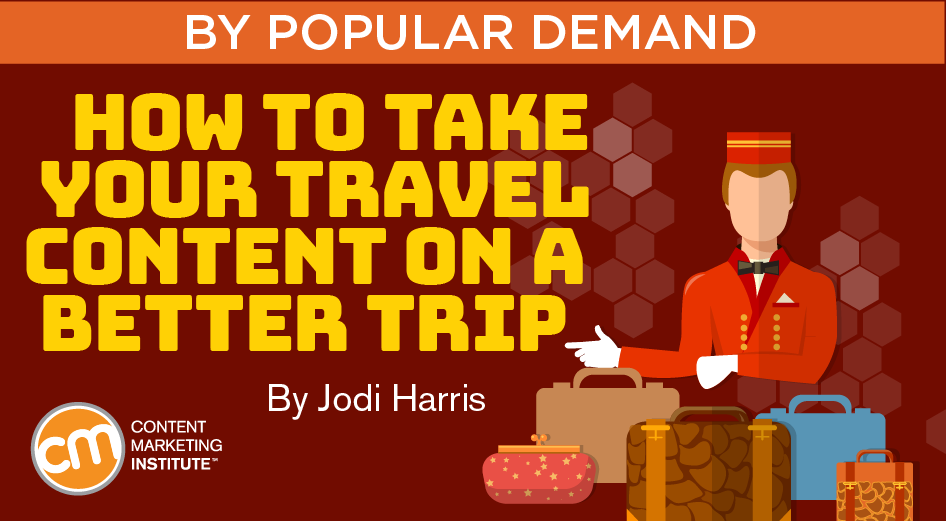Time and place matter – a lot According to Andrew Davis, bestselling author of Town Inc. and host of the Travel, Tourism, and Hospitality Lab at Content Marketing World 2018, travel is one of the only industries where the place you do business matters just as much as the business you do. When it comes to content, Andrew advises, focus less on what you offer as a business and more on compelling people to want to visit your location. Andrew also points out how timing and seasonality play a much bigger role in travel and tourism marketing compared to other industries. Tourism and hospitality marketers need to go the extra mile when it comes to creating content that distinguishes the experiences they offer and earns bookings, not just “lookings.” “Travel businesses don’t do enough to leverage the things that make their destinations truly unique,” says Andrew. You must strike a balance between inclusivity and exclusivity While your content can (and should) communicate your destination’s universal appeal, Andrew says you can gain a greater competitive advantage by focusing on what makes your destination uniquely valuable to one audience niche – i.e., a group of people whose passions may not be equally accommodated anywhere else. Content opportunities in travel and tourism Despite the significant challenges, your travel and tourism business has plenty of advantages when it comes to creating content. The attention earned by sharing inspiring ideas, useful information, and fun content experiences can help your business stand out when those engaged consumers are ready to book their travel. Still, travelers need to navigate many practical decisions to make any journey (fantasy or otherwise) a success. But, given the caliber of the content in the brand’s City Guide app, maybe it should be – especially for those accustomed to traveling in high style. This requires some give and take, so it’s important to highlight, promote, and engage with local visionaries, as well as other influencers who can help increase the appeal of your destination and your business.

Editor’s note: In case you missed this post last year, we’re bringing it back and adding some fresh content too.
I’ve heard there are people who believe that “getting there is half the fun.” But to me, everything that happens between my decision to leave my house and my lying on a beach chair with a fruity drink in my hand is just stress-inducing static and delayed gratification.
To reduce the friction I’m likely to experience when I embark on a trip, I rely on the advice and assistance that travel experts provide online. And, judging from the sheer number of content creators who operate in this space, I’m not the only one.
With so many touchpoints to engage with, so many ways to facilitate and enhance the customer’s journey, and so many pain points your business can help them overcome, content marketing in the travel and hospitality field offers tremendous opportunities to build trust, create memorable moments, and add unique value for intrepid world explorers, road-weary business travelers, and everyone in between.
Travel and tourism content is no endless summer
Of course, as a travel industry marketer, you know your job involves a lot more than just posting some inspirational picturesque snapshots and telling tales of fun in the sun. You face significant challenges when it comes to successful storytelling in this space, not to mention plenty of competition.
Time and place matter – a lot
According to Andrew Davis, bestselling author of Town Inc. and host of the Travel, Tourism, and Hospitality Lab at Content Marketing World 2018, travel is one of the only industries where the place you do business matters just as much as the business you do.
Unlike the experience in industries where the digital universe has flattened the world and opened new opportunities, growth in travel and tourism depends on your business’s ability to get people out of their homes (and away from their computers) and into the physical places in which you operate.
When it comes to content, Andrew advises, focus less on what you offer as a business and more on compelling people to want to visit your location. “You’ve got to increase demand for the particular destination you serve, first and foremost,” he says.
Andrew also points out how timing and seasonality play a much bigger role in travel and tourism marketing compared to other industries. For example, while consumer product goods and other retail marketers have a consistent, primary boom time (i.e., the end-of-year holidays), travel destinations often need to focus the bulk of their marketing efforts around smaller and more location-dependent events, which can occur at any time throughout the year (think of Indio, California, which has its boom time every April during the Coachella Valley Music and Arts Festival, or a mountain resort that gets a surge in visitors during ski season).
Furthermore, every touchpoint in travel experiences is highly subject to disruption from unpredictable factors, like fluctuations in fuel prices, current travel trends, and even natural disasters. These influences can vastly impact pricing and profitability from year to year – and exponentially complicate your content marketing strategy.
Everyone is a potential competitor
From huge hotel chains to boutique B&Bs, and from tour providers to beach equipment rental providers, it seems everyone has travel information to share online. And it’s not always clear whose is the most accurate, trustworthy, or useful. Tourism and hospitality marketers need to go the extra mile when it comes to creating content that distinguishes the experiences they offer and earns bookings, not just “lookings.”
“Travel businesses don’t do enough to leverage the things that make their destinations truly unique,” says Andrew.
The use of beautiful photos of mountains, beaches, and attractions like roller coasters has become ubiquitous – on both travel-related sites and consumers’ websites and social channels. Little distinguishes one destination from another. Travel industry marketers are good at telling people that we’re different, but not as good at demonstrating it, he says.
You must strike a balance between inclusivity and exclusivity
While your content can (and should) communicate your destination’s universal appeal, Andrew says you can gain a greater competitive advantage by focusing on what makes your destination uniquely valuable to one audience niche – i.e., a group of people whose passions may not be equally accommodated anywhere else.
For example, in a recent video conversation, Andrew points out that Roanoke, Virginia, built its marketing and tourism strategy around making sure mountain biking aficionados believe it offers the best experience on the East Coast – right down to creating T-shirts that feature a clever spin on the state’s popular tourism slogan, Virginia Is For Lovers.

Tech raises the stakes for personalization
Deloitte’s 2018 Travel and Hospitality Industry Outlook brings up another reason it’s critical for travel brands to specialize: the latest technological advances, which enable travel marketers to create “personalized moments that matter.”
The travel industry is “on the verge of an evolutionary leap, where the relationship between customer and brand is becoming…

COMMENTS